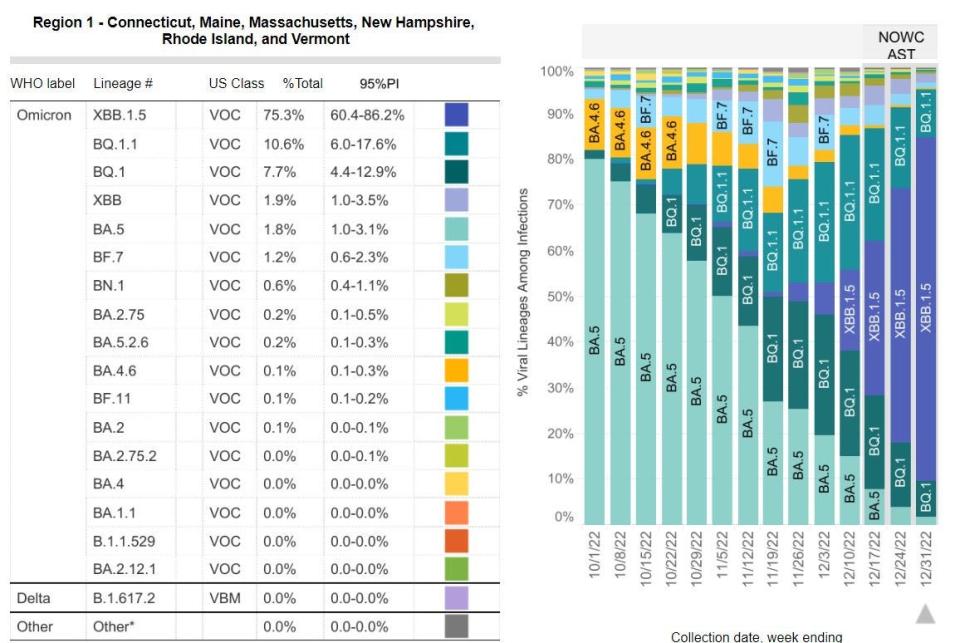What to know about XBB.1.5, the latest COVID-19 concern in New England
WORCESTER ― Should people in Worcester be worried about XBB.1.5, the latest COVID-19 subvariant sweeping the country?
“Sure” said Dr. Robert Klugman, an internal medicine physician at UMass Memorial Health. “It’s the premier subvariant right now. It’s figured out that it’s smarter than the BQ’s and other [subvariants].
“It’s blowing through.”
Klugman’s mention of BQ refers to BQ.1 and BQ.1.1, subvariants of the omicron variant that are still out there, but not at the rate of XBB.1.5. It's the fastest-developing COVID-19 subvariant we’ve seen so far in the United States, said Klugman, and is expanding rapidly in the Northeast, where 75% of all COVID-19 cases last week were tied to XBB.1.5, according to the latest report by the Centers for Disease Control and Prevention.

UMass Memorial Health doesn’t track subvariants among its COVID-19 patients, but Klugman said he believes the XBB.1.5 percentage at UMass likely matches the 75% reported by the CDC.
Thursday, the health care system reported 99 COVID-19 patients, including 11 in the ICU. The day before, the numbers were 109 and 12, respectively.
Those numbers represent an increase compared to 36 and 6, respectively, in early December, according to the state Department of Public Health COVID-19 database. One year ago, at the end of December 2021, there were 135 hospitalizations with 41 in the ICU.
Klugman cited two reasons why the latest variant is prevalent in the Northeast and New York, while its share of cases in the Mid-Atlantic region hovers around 30% and the percentages in the rest of the country are even lower.
One is that viruses generally move from east to west. Another is colder temperatures in the Northeast, driving people indoors where variants can spread.
More dangerous?
Klugman agrees with Dr. Ashish Jha, COVID-19 response coordinator at the White House, that XBB.1.5 is likely better able to infect those who've already contracted COVID-19, compared to earlier variants and subvariants.
Plus, it’s more contagious.
As for whether XBB.1.5 is more dangerous, Klugman said the jury is still out. To put the potential danger in perspective, the latest CDC report shows hospitalizations increased 2.3% nationally from Dec. 7 to 13, compared to the prior seven-day period, while deaths dropped 13.2%.
Why is XBB.1.5 taking hold?
Two reasons, according to Klugman.
It takes less of XBB.1.5 to infect your body, as the virus binds more avidly to the ACE2 receptors that serve as gateways for the virus into the body. Plus, less time and volume of air is required for the virus to spread.

“Fifteen minutes [of time indoors] and six feet [for social distancing] may be out the window” when it comes to XBB.1.5, said Klugman.
What lies ahead?
Klugman isn’t sure, but is looking at various numbers to see how long XBB.1.5 could linger.
One is the number of health care staff at UMass Memorial Health infected with COVID-19. Currently, it’s roughly 40 daily, double the number compared to two weeks ago. He's also aware that since Monday was a holiday, and sickness normally lasts 48 to 72 hours after exposure to COVID-19, then that means infection numbers could drop this weekend.
If they don’t, then “you can give credit to XBB.1.5,” said Klugman.
Message continues
Since the pandemic started nearly three years ago, public health officials continue to stress the importance of getting vaccinated, masking, social distancing, circulation of fresh air indoors and hand washing.
The public has heard the recommendations many times before, and Klugman said it’s important to keep following these preventive measures to protect oneself against XBB.1.5.
In addition, those who haven’t gotten the bivalent booster should do it. Research studies prove the shot boosts immunity against COVID-19 and limits the severity of illness, said Klugman.
Nationally, only 15% of residents have the bivalent booster, according to the CDC. Worcester is expected to release its rate on Friday when it presents its weekly COVID-19 report. In early December, the city's rate was 8%.
Don't forget the flu
While XBB.1.5 is a concern, so is influenza.
Klugman mentioned two striking numbers: 13,000 flu deaths nationwide and over 200,000 hospitalizations so far this flu season.
“Flu is making people sick in the hospital,” said Klugman. “Those who get flu and COVID together, holy maceral. We still have flu to deal with.”
Contact Henry Schwan at henry.schwan@telegram.com. Follow him on Twitter @henrytelegram
This article originally appeared on Telegram & Gazette: XBB.1.5 is the latest COVID variant of concern in New England
